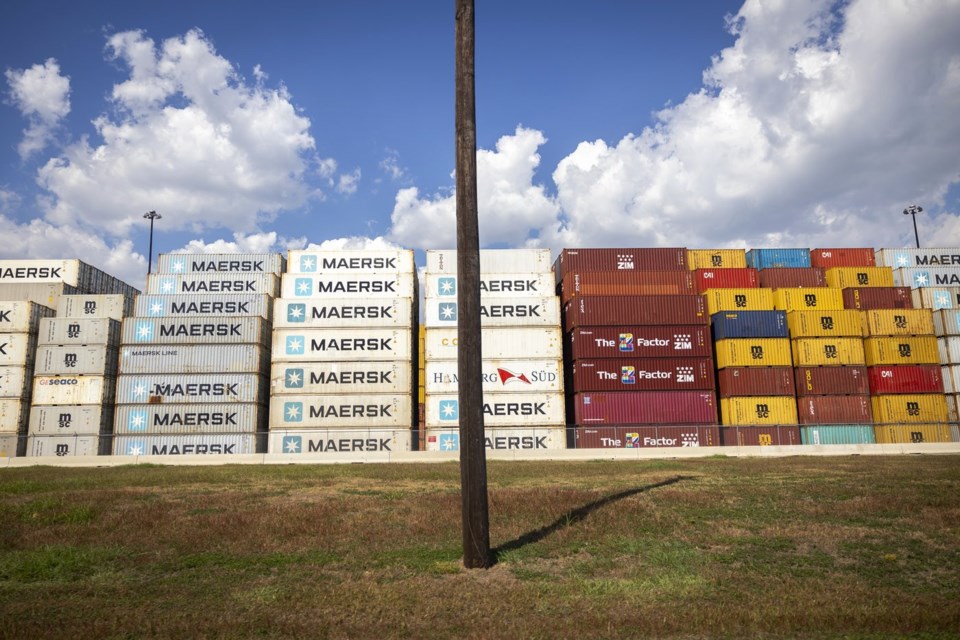NEW YORK (AP) — U.S. ports from Maine to Texas shut down this week when the union representing about 45,000 dockworkers went on strike for the first time since 1977.
The union representing the striking U.S. dockworkers, the International Longshoremen’s Association, reached a deal Thursday to suspend the strike until Jan. 15 to provide time to negotiate a new contract.
Workers had begun walking picket lines early Tuesday near ports all along the East and Gulf coasts.
A shutdown lasting more than a few weeks could have led to higher prices and shortages of goods throughout the country as the holiday shopping season — along with a tight presidential election — approaches.
What are the issues in the dockworkers strike?
The union was demanding significantly higher wages and a total ban on the automation of cranes, gates and container-moving trucks that are used in the loading or unloading of freight at 36 U.S. ports. Those ports handle roughly half of the nations’ cargo from ships.
The contract between the ILA and the United States Maritime Alliance, which represents the ports, expired Tuesday.
The union’s opening demand was a 77% pay raise over the six-year life of the contract, with ILA President Harold Daggett saying that it would make up for inflation and years of small raises. ILA members make a base salary of about $81,000 per year, but some can pull in over $200,000 annually with large amounts of overtime.
The ports sweetened their wage offer from about 50% over six years to 62%. Any wage increase would have to be approved by union members as part of the ratification of a final contract.
Which ports were affected?
While any port can handle any type of goods, some ports are specialized to handle goods for a particular industry. The ports affected by the shutdown included Baltimore and Brunswick, Georgia, the top two busiest auto ports; Philadelphia, which gives priority to fruits and vegetables; and New Orleans, which handles coffee, mainly from South America and Southeast Asia, various chemicals from Mexico and North Europe, and wood products from Asia and South America.
Other major ports affected include Boston; New York/New Jersey; Norfolk, Virginia; Wilmington, North Carolina; Charleston, South Carolina; Savannah, Georgia; Tampa, Florida; Mobile, Alabama; and Houston.
Could the government have intervened?
If a strike were deemed a danger to U.S. economic health, President Joe Biden could have, under the 1947 Taft-Hartley Act, sought a court order for an 80-day cooling-off period. That would have suspended the strike.
But Biden told reporters he would not invoke the act. Instead, the administration worked behind the scenes to encourage the port operators and shipping companies to settle.
How will this affect consumers?
With the strike being suspended, consumers probably won’t notice any significant shortages or price hikes. Had the stoppage persisted for more than a month, it would have been a different story, depending on what you were shopping for. Most holiday retail goods have already arrived from overseas, so there is a buffer. Prices on everything from fruits and vegetables to cars could have headed higher, at least temporarily, if it had dragged on.
That would have been unwelcome news after snarled supply chains sent prices jetting higher at the end of the pandemic, and could have been potentially damaging politically with Election Day about a month away.
What about toilet paper?
The American Forest and Paper Association, which represents makers of toilet paper, facial tissues, paper towels and other wood products, said it was not aware of that the strike had any impact on tissue product delivery in the U.S.
The association said it spoke out after seeing reports on social media of consumers stocking up on toilet paper. It’s a common reaction in times of crisis; shoppers also hoarded toilet paper in the early days of the COVID-19 pandemic.
The trade group said about 85% of toilet paper, paper towels, napkins and tissues used in the U.S. is made by U.S.-based producers and was not affected by the strike.
Businesses had made contingency plans
Since the major supply chain disruption in 2021, retailers have adapted to supply chain disrupters being the new norm, said Rick Haase, owner of a mini-chain of Patina gift shops in and around the Twin Cities in Minnesota.
“The best approach for Patina has been to secure orders early and have the goods in our warehouse and back rooms to ensure we are in stock on key goods,” Haase said.
Still, housing those goods for longer can have an inflationary impact at the register because retailers will need to recoup those storage costs, or absorb them.
Jay Foreman, CEO of Basic Fun, a Boca Raton, Florida, the maker of Care Bears and Lincoln Logs, has already shifted all of the toy company's container shipments away from the East Coast to West Coast ports, primarily Los Angeles and Long Beach. That too, comes with a cost.
The maneuver added anywhere from 10% to 20% in extra costs that his company will have to absorb because Basic Fun’s prices for the next 10 months are locked in with retailers. But Foreman would consider raising prices during the second half of 2025 if the strike is prolonged.
Daniel Vasquez, who owns the import, export specialty company Dynamic Auto Movers in Miami, increased inventory, specifically for vehicles that take longer to ship, in anticipation of a strike.
He too stopped relying on one port or shipping partner and has expanded his relationship with smaller ports and shipping companies that can bypass congested areas.
___
AP Writers Brendan Farrington in Tallahassee, Florida; Stephen Groves in Dover, Delaware; Anthony Izaguirre in Albany, New York; Tom Krisher in Detroit; and Colleen Long in Washington contributed to this report.
Mae Anderson And Anne D'innocenzio, The Associated Press


